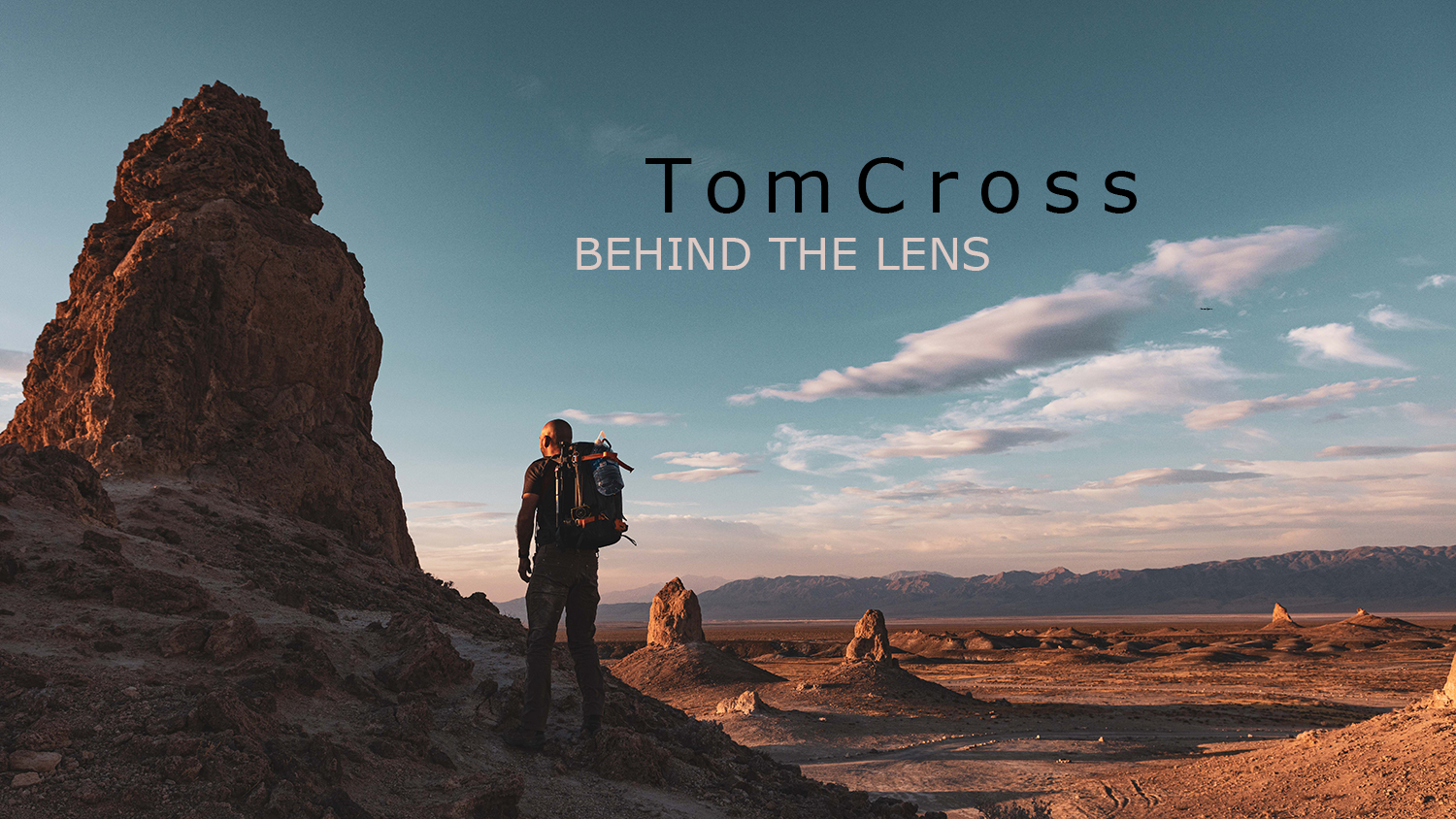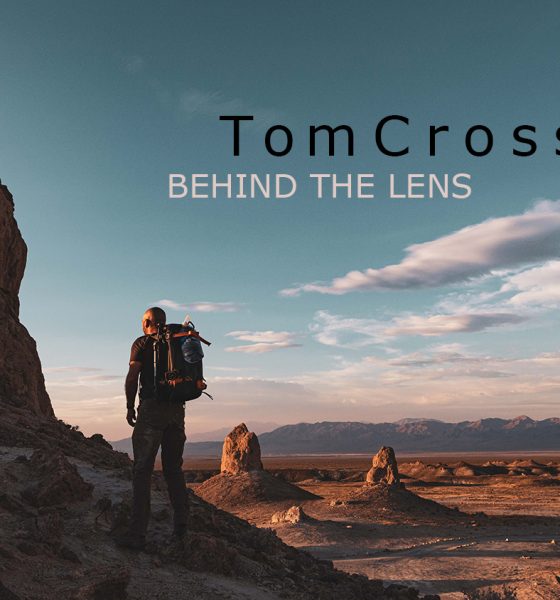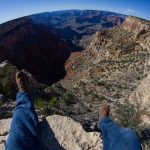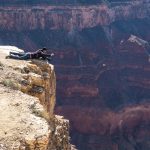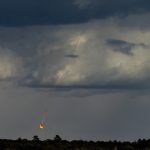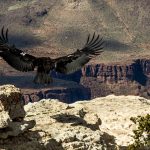You recognize me as a rocket photographer, but I’m often asked about what I shoot when I’m not photographing a launch. In my blog, I’ll take you with me on some of my personal adventures with my camera, and dive into my life Behind the Lens.
Through writing, I’ll share pieces of life-changing, frightening, and always extraordinarily beautiful places and moments I’ve experienced. I think you’ll see that my passion for photographing rockets isn’t that far removed from my passion of photographing Earth. I’m an adventure photographer when I’m not a rocket photographer.
The greatest journeys I’ve been on, so far, have been in the South Western United States. The terrain is extraterrestrial. It’s not oversaturated with cities, I can drive a reasonable amount of time and get away from light pollution and busy interstates. The mountains have the most dynamic weather and environmental differences. You can be in the hottest part of the earth, Death Valley, and see snow-capped mountains on the horizon. There’ll be a drought in one location and waterfalls from snowmelt in another, all within driving distance. It’s nature at its richest and most intense.
I’m an adventure photographer when I’m not a rocket photographer
Located in Arizona, the South Rim of the Grand Canyon, carved by the sediment-rich water from the Rocky Mountains in Colorado, hence, the name ‘Colorado River’ at the bottom. It’s been flowing for at least 5 million years, scraping the layers of earth to expose time before dinosaurs, even time before life. The very bottom of the Grand Canyon is made of exposed rock that is 2-billion years old, a layer of time where no fossils are located. You can really get a sense of the earth as an actual planet down there.
The size of the canyon is unfathomable. If we’re in a simulation, the display is too much data for our minds to process. There’s so much texture, yet no detail. There’s a lot of life, but no movement. You can see the blue haze of the atmosphere as you look across to the North Rim. You feel like it’s not far, but it’s a couple of miles across. So, naturally, I wanted to toss a rock over the edge. I expected it to go pretty far, instead it actually just appeared to drop straight down. My strongest throw is seemingly very weak and it was that moment the earth just put me in my place…for the first time.
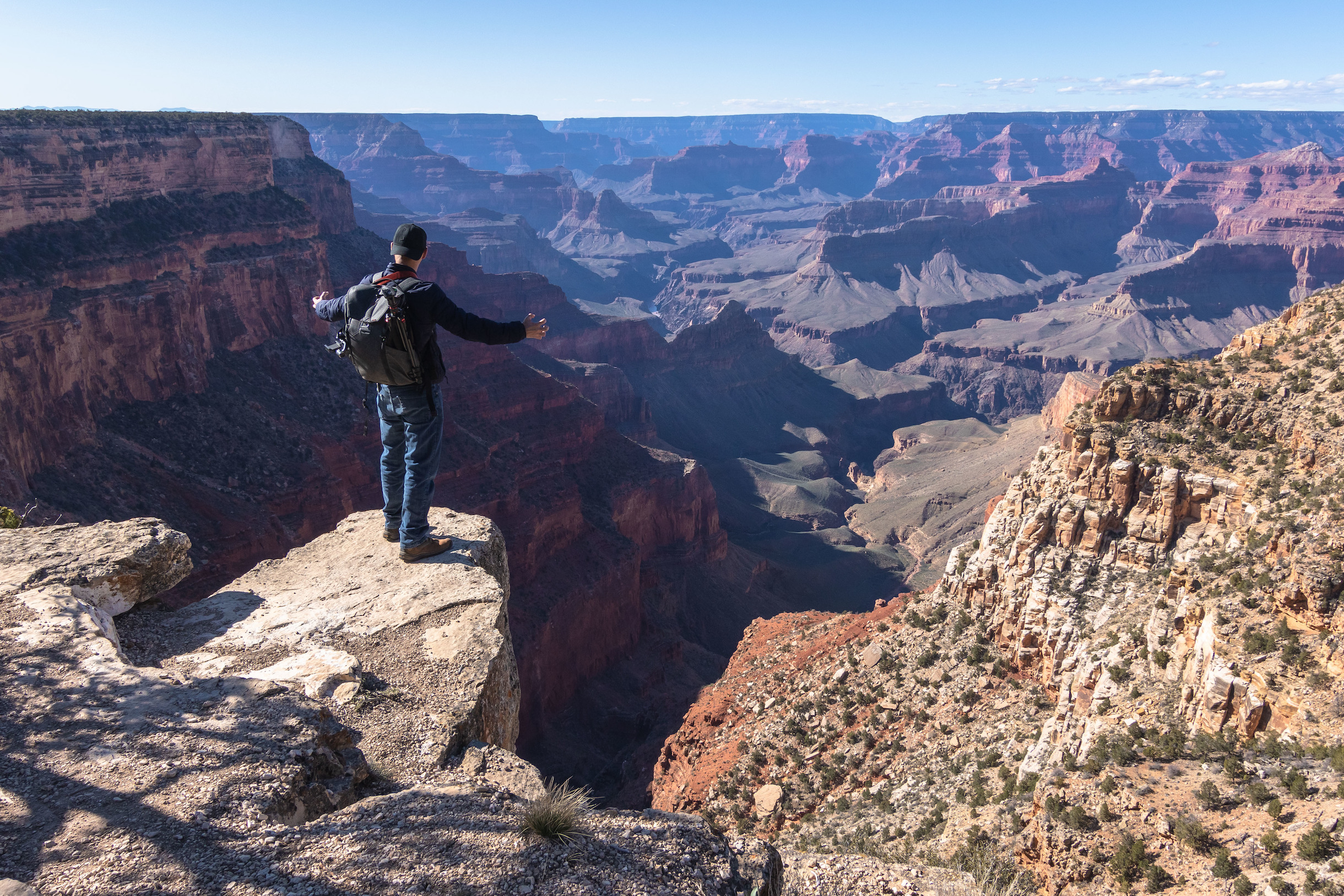
I’m not afraid of the edge of cliffs. For better or worse, my heart rate doesn’t change a bit. So I laid down on my stomach with my head hanging over the edge of the South Rim. I blocked out the sounds of people around me, the safety handrails, imagined all of humanity gone for a while to get the sense that it was just me and this planet.
I thought of how the wind swirled through the canyon while watching majestic vultures, called Condors soar around inside. In my mind, I played a video of what the snow must look like melting in the Rockies and water trickling through the rocks while gravity pulls it down to a valley to form the river that’s been flowing for millennia. I wondered about the temperature differences between the geological layers, there’s a 20-degree difference between the top of the canyon and the bottom, the bottom is warmer. I tried picturing the ancient oceans and deserts that had formed here time and time again as earth went through its natural cycles. Then, I sat down on the edge with my feet hanging over, I could only capture the wow factor of this feeling by using a fisheye lens on my camera.
- Photo: TomCross
- Photo: TomCross
- Photo: TomCross
- Photo: Tom Cross
I believe humans are meant to explore. We’re supposed to migrate to other locations when seasons change. To me, it feels as natural as our circadian rhythm but we’ve interrupted that natural cycle by planting ourselves into jobs which often have no greater purpose than a comfortable paycheck. I spent a lot of time reading books by physicists like Steven Hawking, Brian Cox, Carl Sagan, among others who have explored our location in the cosmos and what we know about our position within it. Having a fulfilling career that serves a greater purpose to humanity and being able to explore our vehicle in the cosmos is not a dream.
Back to the adventures; I’ll take you on a soul searching hike through the Grand Canyon. I hiked 21 miles in 2 days, down to the Colorado River on one trail and out of the Canyon on another trail. It was a personal challenge I set for myself and the first time I’d been in a situation like it. I had all of the supplies I thought I’d need for such a hike. I was solo on this hike, all situations had to be handled on my own with only the items I had with me. How does photography fit into this? There are unexpected moments of beauty where the earth just floors me. It reminds me of how small and insignificant we are as an animal. How dangerous it can be and how precious. It gives us life and it takes it away. It’s to be appreciated. I try to capture those moments.
They weren’t conducting a rescue, it was a recovery
Humans, ugh… We are raised to believe we’re the top of the food chain. But we’re a virus to this cellular organism called Earth. These days, there are talented teams of people who are actively doing anything about reversing and preventing more damage to our home & species. Tesla and SpaceX are the pioneers of this movement. For the first time, we have the tools to help fix it in the form of products that we can purchase to leave less of an impact during our time here. Remember, you will die one day, but your impact remains…
In order to remove this inherited feeling of superiority our species is raised with, I had to feel exposed to danger, I had to make sure earth had its way with me. Whatever happens, I’d work my way through it. The danger is accessible in the Grand Canyon, signs on pathways remind people that they will die if they’re not mindful of what they’re doing.
Just before my hike down, I got a dose of reality. A rescue helicopter dropped off a rescue team to a nearby spot of the canyon then it flew away. I wasn’t able to get a clear view of the team in the canyon because National Park Rangers had the trails leading to the location closed. They weren’t conducting a rescue, it was a recovery. The rumor I heard in a restaurant, is that a family was standing near the edge for a photograph with the canyon in the background and someone had slipped off the edge. When the helicopter returned, it took only a few moments for the team to connect to the line and airlift the body from the canyon.
The next day, I’d be doing my solo hike…
‘Til then, have a good one,
– Tom Cross

Lifestyle
Tesla Model S Plaid battles China’s 1500 hp monster Nurburgring monster, with surprising results
There is just something about Tesla’s tuning and refinement that makes raw specs seem not as game-changing.

The Tesla Model S Plaid has been around for some time. Today, it is no longer the world’s quickest four-door electric sedan, nor is it the most powerful. As per a recent video from motoring YouTube channel Carwow, however, it seems like the Model S Plaid is still more than a match for some of its newer and more powerful rivals.
The monster from China
The Xiaomi SU7 Ultra is nothing short of a monster. Just like the Model S Plaid, it features three motors. It also has 1,548 hp and 1,770 Nm of torque. It’s All Wheel Drive and weighs a hefty 2,360 kg. The vehicle, which costs just about the equivalent of £55,000, has been recorded setting an insane 7:04.957 at the Nurburgring, surpassing the previous record held by the Porsche Taycan Turbo GT.
For all intents and purposes, the Model S Plaid looked outgunned in Carwow’s test. The Model S Plaid is no slouch with its three motors that produce 1,020 hp and 1,420 Nm of torque. It’s also a bit lighter at 2,190 kg despite its larger size. However, as the Carwow host pointed out, the Model S Plaid holds a 7:25.231 record in the Nurburgring. Compared to the Xiaomi SU7 Ultra’s record, the Model S Plaid’s lap time is notably slower.
Real-world tests
As could be seen in Carwow’s drag races, however, Tesla’s tech wizardry with the Model S Plaid is still hard to beat. The two vehicles competed in nine races, and the older Model S Plaid actually beat its newer, more powerful counterpart from China several times. At one point in the race, the Xiaomi SU7 Ultra hit its power limit due to its battery’s temperature, but the Model S Plaid was still going strong.
The Model S Plaid was first teased five years ago, in September 2020 during Tesla’s Battery Day. Since then, cars like the Lucid Air Sapphire and the Xiaomi SU7 Ultra have been released, surpassing its specs. But just like the Model Y ended up being the better all-rounder compared to the BYD Sealion 7 and the MG IM6, there is just something about Tesla’s tuning and refinement that makes raw specs seem not as game-changing.
Check out Carwow’s Model S Plaid vs Xiaomi SU7 drag race video below.
Lifestyle
500-mile test proves why Tesla Model Y still humiliates rivals in Europe
On paper, the BYD Sealion 7 and MG IM6 promised standout capabilities against the Model Y.

BYD is seeing a lot of momentum in Europe, so much so that mainstream media has taken every opportunity to argue that the Chinese automaker has beaten Tesla in the region. But while BYD sales this year in Europe are rising and Tesla’s registrations remain challenged, the raw capabilities of vehicles like the Model Y are difficult to deny.
This was highlighted in a 500-mile challenge by What Car? magazine, which showed that the new Tesla Model Y is more efficient, cheaper to run, and more reliable than rivals like the BYD Sealion 7, and even the nearly 400 KW-charging MG IM6.
Range and charging promises
On paper, the BYD Sealion 7 and MG IM6 promised standout capabilities against the Model Y. The Sealion 7 had more estimated range and the IM6 promised significantly faster charging. When faced with real-world conditions, however, it was still the Model Y that proved superior.
During the 500-mile test, the BYD nearly failed to reach a charging stop, arriving with less range than its display projected, as noted in a CarUp report. MG fared better, but its charging speeds never reached its promised nearly-400 kW charging speed. Tesla’s Model Y, by comparison, managed energy calculations precisely and arrived at each stop without issue.
Tesla leads in areas that matter
Charging times from 25% to 80% showed that the MG was the fastest at 17 minutes, while Tesla and BYD were close at 28 and 29 minutes, respectively. Overall efficiency and cost told a different story, however. The Model Y consumed 19.4 kWh per 100 km, compared to 22.2 for MG and 23.9 for BYD. Over the full trip, Tesla’s charging costs totaled just £82 thanks to its supercharger network, far below BYD’s £130 and MG’s £119.
What Car? Magazine’s testers concluded that despite BYD’s rapid sales growth and the MG IM6’s seriously impressive charging speeds, Tesla remains the more compelling real-world choice. The Model Y just offers stability, efficiency, and a proven charging infrastructure through its Supercharging network. And as per the magazine’s hosts, the Model Y is even the cheapest car to own among the three that were tested.
Watch What Car? Magazine’s 500-mile test in the video below.
Lifestyle
Tesla Cybertruck slapped with world’s least intimidating ticket, and it’s pure cringe
One cannot help but cringe and feel second-hand embarrassment at the idea of a person just driving around with a stack of these babies.

A Cybertruck parked at Stanford Shopping Center in California was recently hit with what might be the most try-hard piece of paper ever slipped under a wiper blade: a “fake citation” accusing the driver of supporting a “fascist car.”
The note, shared on X by Tesla staff program manager Ryan Torres, quickly made the rounds on X, where it quickly gained attention as an example of how not to protest.
The world’s least intimidating ticket
According to the citation, the supposed “violation” was “driving a fascist car.” The remedial action? Take the bus, call an Uber, or ride a bike. The note also dubbed Elon Musk a “chainsaw-wielding Nazi billionaire.” Now, protests against Tesla and Elon Musk have become commonplace this year, but one cannot help but cringe and feel second-hand embarrassment at the idea of a person just driving around with a stack of fake anti-Tesla/Musk citations.
Torres pointed out the irony himself in his post on X. Tesla currently employs over 140,000 Americans, and SpaceX has put the U.S. firmly back at the top of space technology. As Torres put it, maybe the person behind the world’s least intimidating ticket should “read a book on innovation before vandalizing” other people’s property.
Peak performative clownery
Not to mention that the fake ticket’s logic collapses under its own weight. EVs like the Cybertruck are literally designed to reduce emissions, not “destroy the economy.” If anything, Tesla has bolstered the United States’ economy by fueling jobs in engineering, manufacturing, and clean energy. It’s not the first time a Tesla has been the target of vandalism or politically charged notes, but this one stands out for sheer cringe value.
Torres summed it up neatly: “Peak clownery.” On that point, at least, the citation earns full marks. In a way, though, perhaps cringe fake tickets are not as bad as the literal firebombs that were being thrown at Tesla stores and cars earlier this year because some critics were gleefully misinformed about Elon Musk.
